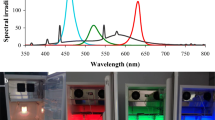Abstract
The detrimental effect of solar radiation on the survival of conidia of the entomopathogenic fungusPaecilomyces fumoroseus was studied by monitoring germinability and ability to form colonies (CFU) of conidia irradiated at two temperatures, 25 and 35 °C, harmless to shaded conidia. There was no apparent effect when spores were exposed to a high level of artificial radiation (0.66 W m−2 UVB). However, at a lower level of irradiance (0.33 W m−2), effects of radiation occurred more quickly at 35 °C than at 25 °C. Under natural solar radiation, the rate of decrease in germinability or viability was doubled at 35 °C as compared to 25 °C, indicating an interaction between temperature and radiation effects under natural conditions. This interaction was not detected in indoor experiments, indicating that the spectral distribution of UV radiation has to be taken in account as well as its irradiance when studying its effects.
Similar content being viewed by others
Abbreviations
- CFU:
-
Colony Forming Units
- UTC:
-
Universal Time Coordinates
- UVB:
-
Ultra Violet B radiation (280–320 nm)
References
Brown GC. Modeling. In: Fuxa JR, Tanada Y, eds. Epizootiology of Insect Diseases. New York: John Wiley, 1987: 43–68.
Onstad DW, Carruthers RI. Epizootiological models of insect diseases. Annu Rev Entomol 1990; 35: 399–419.
Ignoffo CM, Hostetter DL. Environmental stability of microbial insecticides. Misc Publ Entomol Soc Am 1977; 10: 1–80.
Ferron P, Fargues J, Riba G. Fungi as microbial insecticides against pests. In: Arora DK, Ajello L, Mukerji KG, eds. Handbook of Applied Mycology. New York, M. Dekker Inc, vol 2, 1991:665–706.
Carruthers RI, Haynes DL. Temperature, moisture, and habitat effects onEntomophthora muscae (Entomophthorales: Entomophthoraceae) conidial germination and survival in the onion agroecosystem. Environ Entomol 1986; 15: 1154–1160.
Fargues J, Rougier M, Goujet R, Itier B. Effet du rayonnement solaire sur la persistance des conidiospores de l'hyphomycète entomopathogène,Nomuraea rileyi, à la surface du couvert végétal. Entomophaga 1988; 33: 57–370.
Inglis GD, Goettel MS, Johnson DL. Persistence of the entomopathogenic fungus,Beauveria bassiana, on phylloplanes of crested wheatgrass and alfalfa. Biological control 1992; 3: 258–270.
Rotem J, Wooding B, Aylor DE. The role of solar radiation, especially ultraviolet, in the mortality of fungal spores. Phytopathol 1985; 75: 510–514.
Rougier M, Fargues J, Goujet R, Smits N. Photic effect of solar U.V. radiations on the survival of entomopathogenic hyphomycete. In: Varlet-Grancher C, Bonhomme R, eds. Crop structure and light microclimate: characterisation and applications. Paris, France: INRA, Coll Science Update, 1992: 433–438.
Rougier M, Fargues J, Goujet R, Itier B, Benateau S. Mise au point d'un dispositif d'étude des effets du rayonnement sur la persistance des microorganismes pathogènes. Agronomie 1994; 14: 673–681.
Maniania NK, Fargues J. Spécificité des hyphomycètes entomopathogènes pour les larves de lépidoptères Noctuidae. Entomophaga 1984; 29: 451–464.
Gilchrist JE, Campbell JE, Donnely CB, Peeler JT, Delaunay JM. Spiral plate method for bacterial determination. Appl Microb 1973; 43: 149–157.
Bouamama, N. Effet de l'eau en phase vapeur et en phase liquide sur la survie des conidiospores dePaecilomyces fumosoroseus (WIZE) BROWN et SMITH, hyphomycète pathogène deSpodoptera frugiperda (Lep. Noctuidae) en conditions contrôlées. [Thèse de Doctorat]. Paris, France: Univ Paris VI, 1992.86 pp.
Wexler A, Hasegawa S. Relative humidity-temperature relationships of some saturated salt solutions in the temperature range 0 ° to 50 °C. J Res ntl Bur Stand 1954; 53: 19–26.
ASTM (American Society for Testing Materials). Maintaining constant relative humidity by means of aqueous solutions. Standards 1958; 6: 961.
Rockland LB. Saturated salt solutions for static control of relative humidity between 5 ° and 40 °C. Anal Chem 1960; 32: 1375–1376.
Fargues J, Rougier M, Goujet R, Smits N, Coustere C, Itier B. Inactivation of conidia ofPaecilomyces fumosoroseus by near ultraviolet (UVB and UVA) and visible radiation. J Invertebr Pathol 1996 (in press).
Tevini M. Molecular biological effects of ultraviolet radiation. In: Tevini M, ed. UV-B radiation and ozone depletion: effects on human, animals, plants, microorganisms, and materials. Boca Raton, FL, USA: CRC Press, 1993. 1–15.
Bashi E, Aylor DE. Survival of detached sporangia ofPeronospora destructor andPeronospora tabacina. Phytopathology 1983; 73: 1135–1139.
Smits N. Approche de la modélisation des effets du rayonnement solaire sur la persistance des spores quiescentes de l'hyphomycète entomopathogènePaecilomyces fumosoroseus (Wize) Bown & Smith [Thèse de Doctorat]. Lyon, France: Univ Claude Bernard Lyon I, 1992. 131 pp.
Smits N, Fargues J, Rougier M. Modelling the persistence of quiescent conidia of the entomopathogenic hyphomycetePaecilomyces fumosoroseus exposed to solar radiation. Biocontrol Sci Technol 1996; submitted for publication.
Becker RA, Chambers JM, Wilks AR, eds. The new S language. A programming environment for data analysis and graphics. Pacific Grove, California: Wadsworth and Brooks/Cole Advanced Books & Software, 1988. 702 p.
Huet S. Maximum likelihood and least squares estimators for a nonlinear model with heterogeneous variances. Statistics 1986; 17: 517–526.
SAS Institute Inc. Sas/STAT User's Guide, Release 6.03 Edition. Cary, NC, USA: SAS Institute Inc. 1988. 1028 pp.
Zimmermann G. Effects of high temperatures and artificial sunlight on the viability of conidia ofMetarhizium anisopliae. J Invertebr Pathol 1982; 40: 36–40.
Rotem J, Aust HJ. The effect of ultraviolet and solar radiation and temperature on survival of fungal propagules. J Phytopathol 1991; 133: 76–84.
Maddison BC, Manners JG. Lethal effects of artificial ultraviolet radiation on cereal rust uredospores. Trans Br Mycol Soc 1973; 60: 471–494.
Author information
Authors and Affiliations
Corresponding author
Rights and permissions
About this article
Cite this article
Smits, N., Fargues, J., Rougier, M. et al. Effects of temperature and solar radiation interactions on the survival of quiescent conidia of the entomopathogenic hyphomycetePaecilomyces fumosoroseus (Wize) Brown and Smith. Mycopathologia 135, 163–170 (1996). https://doi.org/10.1007/BF00632338
Received:
Accepted:
Issue Date:
DOI: https://doi.org/10.1007/BF00632338




